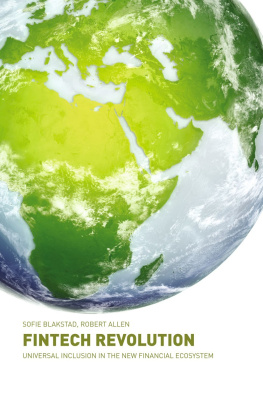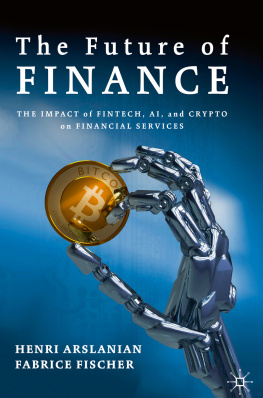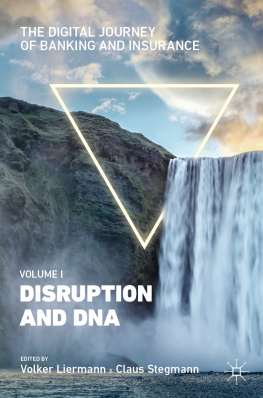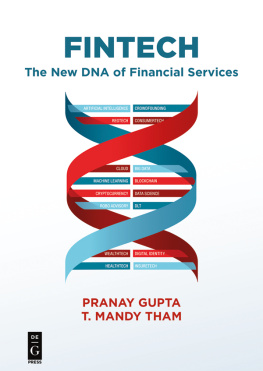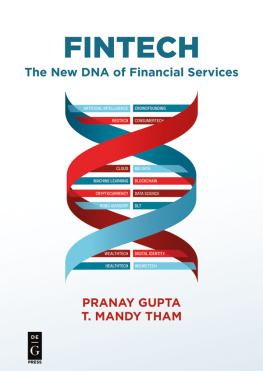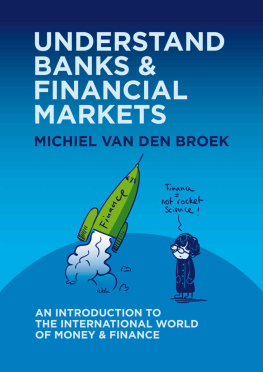Financial services are changing. Following the 2008 crisis, new services have evolved to challenge, supplement and supplant banks.
The first half of this book explores the evolution of financial services away from the monoliths into the ecosystem , and the implications for underserved customersthe unbanked , largely (but not exclusively) in developing economies, and small businesses everywhere, who have been suffering from limited availability and high cost of banking services, while larger corporations continue to grow and benefit from economies of scale, often transcending national boundaries and taxation. We describe both how emerging solutions, exploiting but not driven by technology, are already having an impact, and the further, greater impact that will follow.
We show how these solutions are helping to fuel the growing drive towards finding sustainable business solutions, in support of the UNs Sustainable Development Goals and enabling communities everywhere to be self-supporting and sustainable.
This half focuses, necessarily, on exploring the technologies that will support and partially drive the evolution. A key technology is blockchain and its many potential applications, together with the enormous implications it has for disrupting traditional notions of money, value and transactions. But this isnt a book about blockchain so much as the ecosystem economy that it will enable, which is already emerging around us, despite all the technical limitations in our legacy systems.
And that gives us good reason to state with confidence that the Fintech Revolution is already happening; the nascent ecosystem economy is already here, and the new financial ecosystem is beginning to emerge.
What's Behind It?
In developed economies, most people see banks as a necessity; like schools, transport or food shops, theyre part of the familiar infrastructure of modern capitalism, and we would struggle to function normally without them. But banks as we know them, and the traditional financial system, are changing. Following the crash of 2008, governments and regulators have encouraged greater competition in the financial system to mitigate the too big to fail risks that contributed to the crisis; but banks are struggling to change, while alternate financial services are gaining ground.
In this part we examine the challenges banks are facing in moving into the new ecosystem economy, the alternate services that will replace many of their current offerings, and the impact this is likely to have on the financial services industry, its customers, and the wider economy.
1. Ecosystem vs Egosystem and Revolution vs Evolution
Banks need to move into the ecosystem to participate in the new economy, but its not easy.
In this chapter, we consider the forces driving us from traditional financial services to the emerging financial ecosystem . We examine the way financial services organisations have been structured to date, and the binding forces that are keeping them that way, despite efforts to change. We discuss the factors that have allowed the ecosystem economy to emerge, and how the transition is happeningwith some examples of organisations that are successfully bridging the gap.
The change is radical, fundamental, holistic and impacts all aspects of financial services; we consider the level of disruption that will be required or result from the transition, and ask whether relatively pain-free evolution will be overcome by a more compromising, dramatic and painful revolution.
Dinosaurs and Dynasties: The Financial Services Egosystem
Banks evolved from individuals holding big buckets of money. The guy holding the purse strings (literally, at first) called the shots. Banks grew as balance sheets and customer numbers grew and became giants at a time when labour was cheap, computing was in its infancy, and popular management theory held that hierarchical organisations were the lifeblood of the economy. Corporate pyramids, beloved by American organisations of the 1950s to 1970s, were still maintaining their apparently unassailable position as the ideal business model, riding on the back of the USs relative economic prosperity following World War II, and subsequently adopted by the world as the cause, rather than a correlation, of that prosperity.
Banks also went through a period of rapid growth and consolidation in parallel with the development of many new products and services, facilitated by relaxing regulations and greater technical opportunities. As banks grew and rewards skyrocketed, they ceased to be boring, safe workplaces and became attractive to ambitious individuals seeking to make their fortune. And those individuals were rewarded; their creativity and hard work supported the sales of a broader range of products to more lucrative markets, and profitability headed skywards too.
Banks were locked into a cycle of making money, attracting talent so that they could make more money, increasing their value and attracting more talent. Regular culls at most institutions cut out any underperformers, ensuring teams were composed of the brightest and most ambitious people. Leaders, however, were rewarded for two key metrics: building bigger teams and making more money. And it worked: as banking practice expanded to previously untapped areas of the market, a growing consumer acceptance of credit and creative secondary products expanded the mortgage books and made gambling on capital markets an increasingly profitable activity; balance sheets grew, salaries continued to escalate and shareholders were happy.
Out of the Crisis?
Then in 2008 the bubble burst, and things changedbut not everything. After the crisis, banks recognised the need to scale back, but the consolidation continued. They were still locked into trying to deliver value for shareholders; even though valuations were in the toilet, they couldnt see a way to reduce their costs by losing key individuals without losing the ability to generate value, so those salaries stayed high, while lower-cost people were let go to bring the numbers down, and people were rewarded for the same old metrics. Because large teams selling products at volume to large numbers of customers require consistency and aggressive selling to make lots of money, originality was discouraged in favour of aggression.
The large team/volume sales approach built generations of leaders who have learned that success is earned by building large teams and making lots of money against aggressive, quarterly targets. It also selected for leaders who were good at these two things. Consequently, most of the leadership teams of banks today are still pretty homogenous; despite the recognition that aggressive, sales-oriented groupthink directly led to the crisis in the first place, it has been challenging for firms to edit out the profile of people that have formed both their leadership teams and their leadership pipelines for decades.
Banks have recognised the cultural challenge and, especially as it becomes increasingly apparent that customers are demanding greater transparency and accountability, are making committed efforts to change. However, despite widespread reform, groupthink and the underlying culture are proving difficult to shift. Why is it so hard?
Cultural Barriers to Transforming for the Ecosystem Economy

